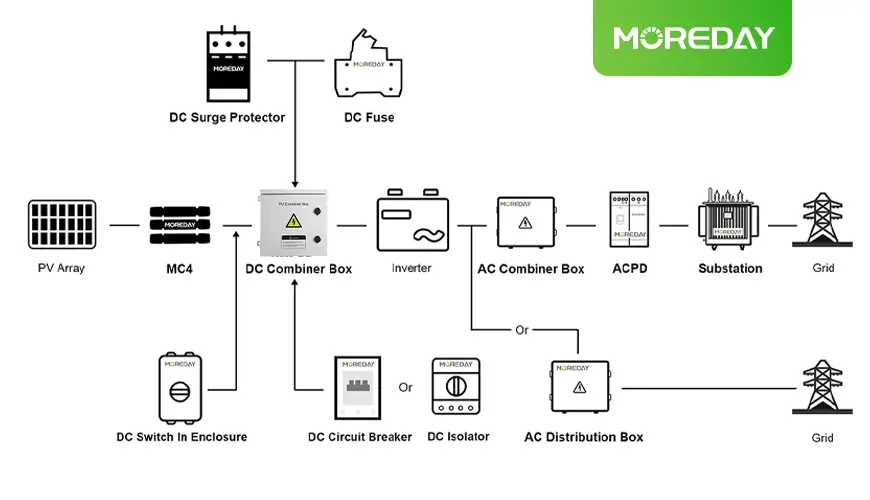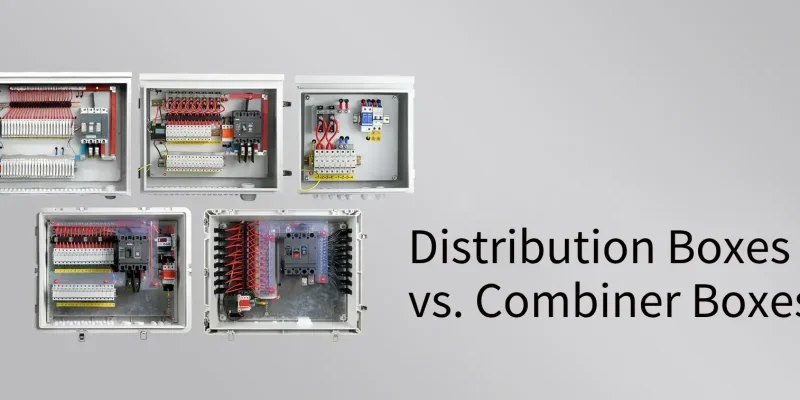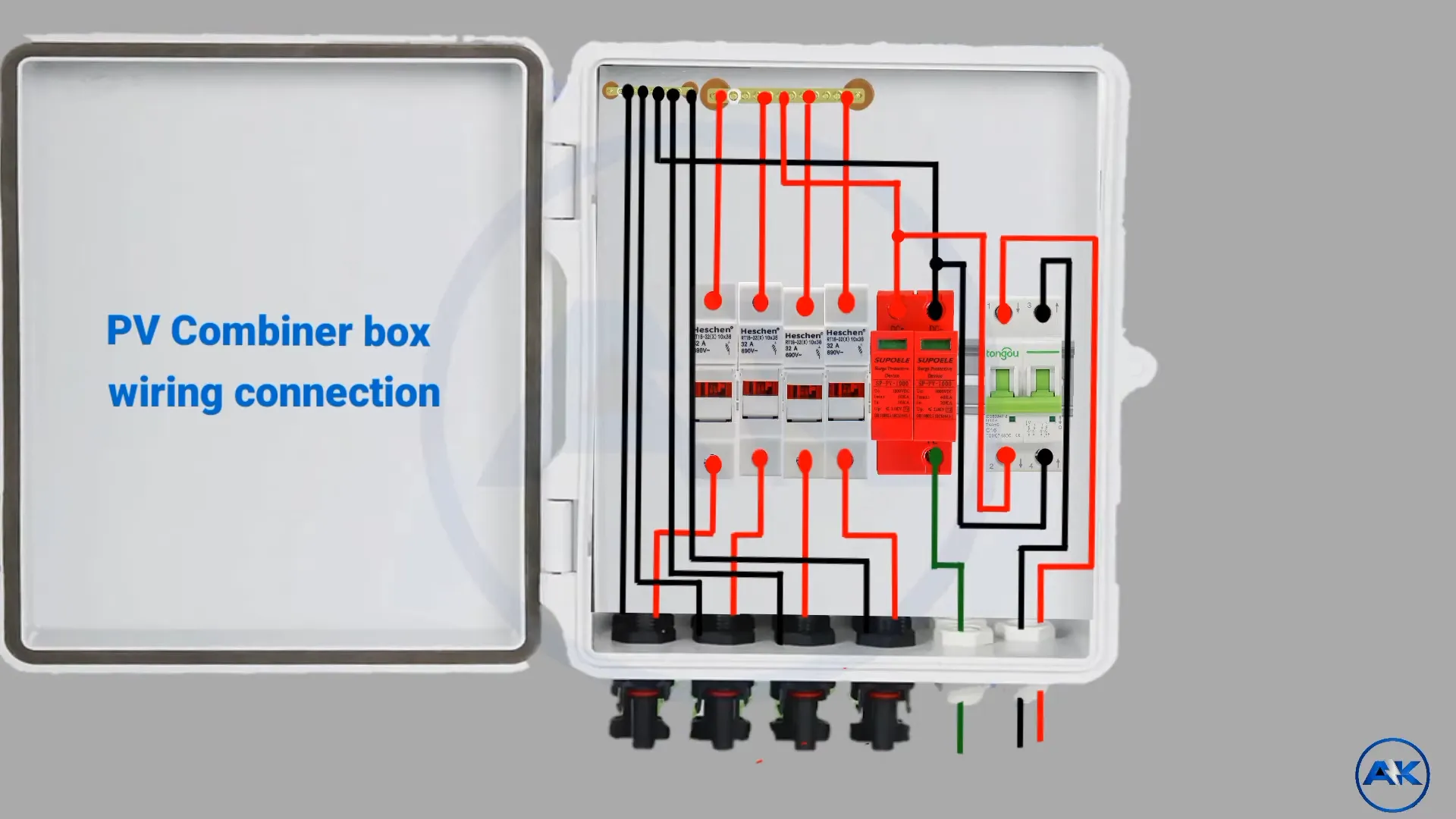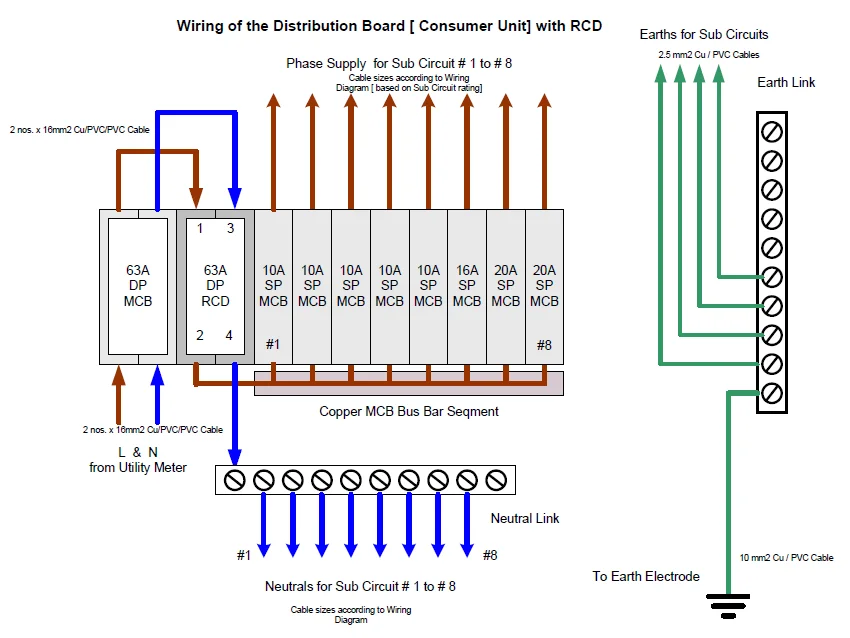Introduction
Dans les systèmes électriques, et en particulier dans les installations solaires photovoltaïques (PV), il est essentiel de comprendre les différences entre les boîtes de distribution et les boîtes de raccordement. Les deux jouent un rôle important, mais sont conçus pour des fonctions distinctes. Ce blog explore les fonctions de chaque boîtier, leurs composants, leurs applications et leurs principales différences.

Crédit à Moreday
Comprendre les boîtiers de distribution
Un boîte de distribution est un point central de distribution de l'énergie électrique à partir d'une source unique vers plusieurs circuits. Il assure une gestion sûre de l'énergie et comprend des éléments de protection tels que des disjoncteurs ou des fusibles pour éviter les surcharges. Voici un aperçu de leurs caractéristiques et de leurs applications :
Fonctionnalité
Les boîtes de distribution sont conçues pour distribuer l'énergie électrique aux différents circuits d'un bâtiment ou d'une installation, en assurant une protection contre les défauts afin de garantir un fonctionnement sûr.
Composants
Une boîte de distribution typique contient
- Disjoncteurs : Protéger chaque circuit contre les surcharges et les courts-circuits.
- Fusibles : Offrent une protection supplémentaire en coupant le circuit en cas de défaut.
- Dispositifs de protection contre les surtensions : Protection contre les pointes de tension.
Applications
Ces boîtes sont largement utilisées dans :
- Milieux résidentiels : Gérer les systèmes électriques domestiques en toute sécurité.
- Paramètres commerciaux : Distribuer efficacement l'énergie dans les immeubles de bureaux et les commerces.
- Milieux industriels : Assurer une bonne gestion de l'énergie pour les machines et équipements lourds.
Conception
Les boîtes de distribution sont conçues pour une utilisation intérieure et extérieure, avec des boîtiers étanches pour les applications extérieures afin de résister aux différentes conditions environnementales.
Comprendre les boîtes de raccordement
Un boîte de raccordement est spécifiquement utilisé dans les systèmes d'énergie solaire pour consolider les sorties de plusieurs panneaux solaires ou onduleurs en une seule sortie. Cela simplifie le câblage et améliore la sécurité globale du système. Ses principales caractéristiques sont les suivantes
Fonctionnalité
Les combinateurs combinent les sorties CC ou CA de plusieurs panneaux solaires ou onduleurs en une seule ligne de sortie, qui est ensuite acheminée vers un onduleur ou le réseau.
Composants
Une boîte de mélange typique comprend
- Fusibles ou disjoncteurs : Prévoir une protection pour chaque chaîne d'entrée.
- Dispositifs de protection contre les surtensions : Protéger contre les pointes de tension.
- Équipement de surveillance : Parfois inclus pour suivre les performances.
Applications
Principalement utilisés dans les systèmes solaires photovoltaïques, les boîtiers de raccordement sont essentiels pour gérer et organiser plusieurs chaînes de panneaux solaires de manière efficace et sûre.
Conception
Les boîtes de raccordement sont souvent conçues pour résister aux intempéries, avec un indice IP65 ou supérieur, ce qui les rend adaptées aux conditions extérieures dans lesquelles les panneaux solaires sont généralement installés.
Comparaison des boîtiers de distribution et des boîtiers combinés
| Aspect | Boîte de distribution | Boîte de raccordement |
|---|---|---|
| Fonction principale | Distribue l'énergie électrique à plusieurs circuits | Combine les sorties de plusieurs panneaux solaires ou onduleurs en une seule ligne |
| Composants typiques | Disjoncteurs, fusibles, dispositifs de protection contre les surtensions | Fusibles ou disjoncteurs pour chaque chaîne, protection contre les surtensions, parfois équipement de surveillance |
| Contexte d'utilisation | Utilisé dans les systèmes électriques généraux dans les environnements résidentiels, commerciaux et industriels | Spécifiquement utilisé dans les systèmes solaires photovoltaïques pour rationaliser et sécuriser le processus de câblage. |
| Mécanisme de protection | Protège les circuits individuels contre les surcharges | Protège contre les surintensités et les surtensions dans les installations de panneaux solaires |
| Lieu d'installation | Convient aux installations intérieures et extérieures, souvent résistant aux intempéries pour une utilisation extérieure | Principalement installés à l'extérieur, près des panneaux solaires, ils sont conçus pour résister aux défis environnementaux. |
Comparaison de la complexité de l'installation
Lorsque l'on compare les boîtiers de distribution et les boîtiers combinés, la complexité de l'installation est un facteur important à prendre en compte. Voici une ventilation des considérations d'installation pour chacun d'entre eux :
- Installation d'une boîte de distribution :
- Généralement plus simple à installer grâce à des composants et des méthodes de câblage standardisés
- Généralement installés à l'intérieur, souvent dans des locaux techniques ou des sous-sols.
- Nécessite une mise à la terre appropriée et le respect des codes électriques locaux.
- Peut nécessiter une installation professionnelle en fonction de la complexité du système électrique.
- Installation de la boîte de raccordement :
- Processus d'installation plus complexe, en particulier pour les systèmes solaires à grande échelle
- Souvent installés à l'extérieur, ils nécessitent des boîtiers résistants aux intempéries.
- Il faut connecter plusieurs chaînes de panneaux solaires, ce qui peut s'avérer complexe.
- Nécessite une planification minutieuse de l'acheminement et de la gestion des câbles
- Peut inclure des composants supplémentaires tels que des dispositifs de protection contre les surtensions ou des systèmes de surveillance.
- Considérations communes :
- Dans les deux cas, les circuits doivent être correctement étiquetés pour faciliter l'identification et l'entretien.
- La complexité de l'installation augmente avec la taille du système pour les deux types de boîtiers
- Une bonne ventilation est essentielle pour éviter la surchauffe, en particulier pour les boîtiers de raccordement des installations solaires.
- Impact sur l'ensemble du système :
- Les boîtiers combinés peuvent réduire de manière significative la complexité du câblage dans les installations solaires, ce qui peut réduire les coûts d'installation globaux.
- Les boîtes de distribution simplifient les extensions futures des systèmes électriques dans les bâtiments
- Les deux types de boîtiers contribuent à l'efficacité et à la sécurité du système lorsqu'ils sont installés correctement
Alors que les boîtes de distribution sont généralement plus simples à installer dans les systèmes électriques traditionnels, les boîtes de raccordement nécessitent des connaissances plus spécialisées en raison de leur rôle dans les systèmes d'énergie solaire. La complexité de l'installation des boîtes de raccordement est compensée par leur capacité à rationaliser les installations solaires à grande échelle et à améliorer les performances du système
Boîtes combinées Raccordement des fils
En savoir plus : https://viox.com/solar-combiner-box-wiring-diagram/
Schéma de câblage des boîtes de distribution
En savoir plus :https://viox.com/distribution-box-and-selection-guide/
Conclusion
En résumé, bien que les boîtes de distribution et les boîtes de raccordement soient toutes deux essentielles à la gestion des connexions électriques, leurs rôles diffèrent considérablement. Les boîtes de distribution sont conçues pour distribuer l'énergie en toute sécurité entre les différents circuits des systèmes électriques généraux, tandis que les boîtes de combinaison sont spécialisées dans l'agrégation des sorties des panneaux solaires avant de les envoyer à un onduleur. Il est essentiel de comprendre ces différences pour sélectionner le dispositif approprié en fonction des exigences spécifiques d'une installation électrique, en particulier dans les systèmes solaires photovoltaïques. Pour des conseils personnalisés et une sélection optimale, il est recommandé de consulter des professionnels.





